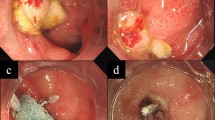Abstract
Pre- and postoperative blood counts were retrospectively compared between patients with no hemostatic management (group A,n = 30) and patients with a fibrin adhesive (Beriplast P) applied to the cut edges (group B,n = 8) when pyloromyotomy was performed for hypertrophic pyloric stenosis. Postoperative red blood cell count, hematocrit, and hemoglobin were significantly decreased in group A (P <0.01) while there was no significant change in group B. It has been stated that the Ramstedt operation does not require any special hemostatic management. However, as postoperative peritoneal bleeding is suspected, hemostatic management with a fibrin adhesive applied to the incised region of the serosa and muscle layer is recommended.
Similar content being viewed by others
References
Benson CD (1986) Infantile hypertrophic pyloric stenosis. In: Welch KJ, Randolph JG, Ravitch MM, et al (eds) Pediatric surgery, 4th edn. Year Book Medical Publishers, Chicago, pp 811–815
Benson CD, Hight DW (1982) Stomach an duodenum. In: Welch KJ (ed) Complications of pediatric surgery. WB Saunders, Philadelphia, pp 274–284
Hilfenhaus J, Weidmann E (1985) Fibrin glue safety; indication of potential viral contaminants by pasteurization of the human plasma components. Arzneimittelforschung 35: 1617–1619
Hyde GA (1982) Complications of surgery on the stomach and duodenum (pyloric stenosis). In: deVries PA, Shapiro SR (eds) Complications of pediatric surgery. John Wiley and Sons, New York, pp 167–169
Kalmar P, Krebber HJ, Poker H, et al (1982) Bioadhesives in cardiac and vascular surgery. Thorac Cardiovasc Surg 30: 230–231
Kram HB, Shoemaker WC, Hino ST, et al (1984) Splenic salvage using biologic glue. Arch Surg 119: 1309–1311
Kreuser ED, Seifried E, Harsch U, et al (1985) Fibrinpleurodese bei malignen Pleuraergüssen. Dtsch Med Wochenschr 110: 1365–1368
Raffensperger JG (1990) Pyloric stenosis. In: Swenson's pediatric surgery, 5th edn. Appleton and Lange, Norwalk, pp 211–219
Scheele VJ, Herzog J, Mühe E (1978) Anastomosensicherung am Verdauungstrakt mit Fibrinkleber. Nahttechnische Grundlagen, experimentelle Befunde, klinische Erfahrungen. Zentralbl Chir 103: 1325–1336
Sieber WK (1980) The stomach. In: Holder TM, Ashcraft KW (eds) Pediatric surgery. WB Saunders, Philadelphia, pp 314–330
Türk R, Weidringer JW, Hartel W et al. (1983) Closure of lung leaks by fibrin gluing. Experimental investigations and clinical experience. Thorac Cardiovasc Surg 31:185–186
Author information
Authors and Affiliations
Rights and permissions
About this article
Cite this article
Yamazaki, Y., Yoshida, T., Mizuno, R. et al. Hemostasis for the Ramstedt procedure: Use of a fibrin adhesive. Pediatr Surg Int 9, 455–456 (1994). https://doi.org/10.1007/BF01686037
Accepted:
Issue Date:
DOI: https://doi.org/10.1007/BF01686037




